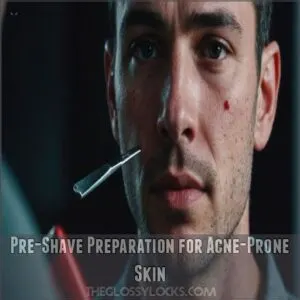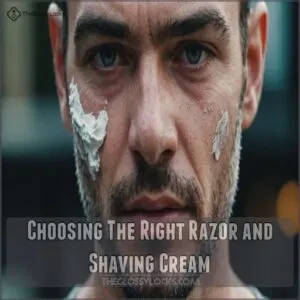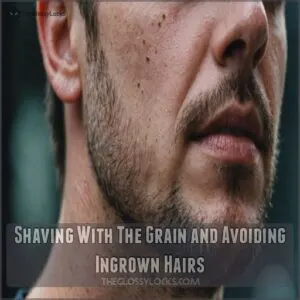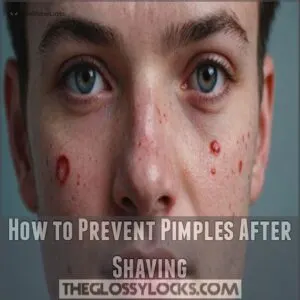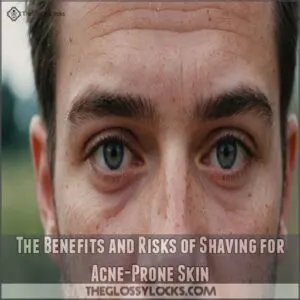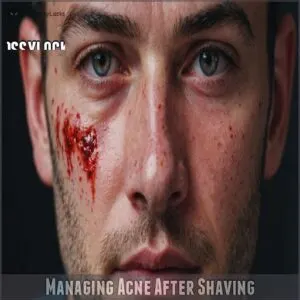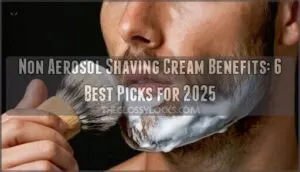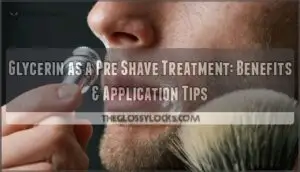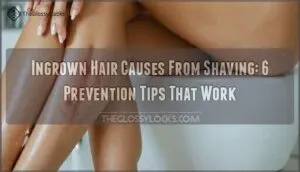This site is supported by our readers. We may earn a commission, at no cost to you, if you purchase through links.
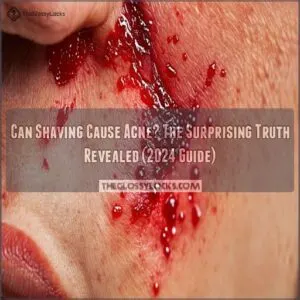 Can shaving cause acne? Not directly, but your shaving routine might be the culprit if you’re not careful. Improper techniques or dull razors can irritate your skin, leading to breakouts that mimic acne. It’s like borrowing trouble you didn’t need!
Can shaving cause acne? Not directly, but your shaving routine might be the culprit if you’re not careful. Improper techniques or dull razors can irritate your skin, leading to breakouts that mimic acne. It’s like borrowing trouble you didn’t need!
To keep your skin happy, use a sharp single-blade razor and non-comedogenic shaving products. Shave with the grain to avoid those pesky ingrown hairs. Remember, a good shave isn’t a race; take your time. With the right techniques, shaving can actually help keep your skin clear and smooth.
Curious about more skin-saving tips? Stay tuned for some surprising insights!
Table Of Contents
- Key Takeaways
- Shaving and Acne: What’s The Connection?
- Shaving Techniques to Prevent Acne
- How to Prevent Pimples After Shaving
- The Benefits and Risks of Shaving for Acne-Prone Skin
- Managing Acne After Shaving
- Frequently Asked Questions (FAQs)
- Can shaving cause acne?
- Should you shave if you have acne?
- How to prevent acne pimples while shaving?
- How to prevent acne after shaving with an electric razor?
- Why do I get acne after shaving?
- Can shaving cause pimples down there?
- Does shaving hair help acne?
- Should acne prone skin shave?
- How does shaving affect sensitive skin types?
- Are there natural alternatives to shaving cream?
- Can diet impact acne related to shaving?
- Whats the best razor type for acne-prone skin?
- Does the shaving frequency influence breakouts?
- Conclusion
Key Takeaways
- Shaving itself doesn’t cause acne, but improper techniques can irritate your skin, leading to breakouts.
- Use a sharp razor and non-comedogenic shaving products to minimize irritation.
- Shave with the grain of your hair growth to prevent ingrown hairs and razor bumps.
- Proper pre- and post-shave care, including moisturizing, is crucial for preventing acne.
Shaving and Acne: What’s The Connection?
You’ve probably wondered if shaving can cause acne, especially if you’ve noticed breakouts after grooming.
While shaving doesn’t directly cause acne, it can irritate your skin and exacerbate existing acne if not done properly.
How Shaving Affects Acne-Prone Skin
Surprisingly, shaving can be a double-edged sword for acne-prone skin.
While it doesn’t directly cause acne, improper shaving techniques can irritate your skin and exacerbate existing issues.
Here’s how shaving affects your acne-prone skin:
- Exfoliation: Properly removing dead skin cells after microneedling procedures, such as through gentle exfoliation techniques, helps maintain skin health and prevent clogged pores. Removes dead skin cells, potentially unclogging pores
- Irritation: Can inflame existing acne if not done carefully
- Ingrown hairs: May lead to razor bumps, often mistaken for acne
- Skin barrier: Improper technique can damage your skin’s protective layer
- Product buildup: Softening hair with warm water or a warm towel before shaving, as part of pre-shave preparation techniques, can help reduce the risk of product buildup. Shaving creams may clog pores if not suitable for your skin type
Can Shaving Cause Acne Breakouts?
Contrary to popular belief, shaving itself doesn’t cause acne.
However, improper shaving techniques can trigger breakouts.
Using dull razors, harsh products, or shaving too aggressively can irritate your skin, leading to razor burn or ingrown hairs that mimic acne.
Additionally, failing to use shaving cream to reduce razor bumps can also lead to skin irritation.
To prevent these issues, use clean, sharp razors and gentle, non-comedogenic shaving products.
Shave with the grain and avoid pressing too hard.
Remember, proper technique is key to keeping your skin clear and smooth.
How to Distinguish Between Razor Bumps and Acne
Let’s clear up the confusion between razor bumps and acne.
While both can be pesky skin issues, they’re quite different beasts.
You can spot the difference by looking at the products designed to help with razor bumps, such as those found at the Razor Bump Solutions.
Appearance: Razor bumps are small, red, and uniform; acne varies in size and type.
Location: Razor bumps stick to shaved areas; acne can pop up anywhere.
Texture: Razor bumps feel rough; acne can be smooth or bumpy.
Pain: Razor bumps often sting; acne usually
Shaving Techniques to Prevent Acne
You can prevent acne while shaving by using the right techniques.
Pre-shave preparation, choosing suitable razors and shaving creams, and shaving with the grain to avoid irritation and ingrown hairs are all effective methods.
Pre-Shave Preparation for Acne-Prone Skin
To minimize the risk of acne and ingrown hairs, consider using a gentle shaving cream specifically designed for sensitive skin, such as those with fragrance-free shaving creams. Now that we’ve covered the connection between shaving and acne, let’s focus on prepping your skin for a smooth shave.
Start by checking your skin’s condition.
Exfoliate gently to remove dead cells and unclog pores.
Cleanse with a mild, acne-friendly soap to banish dirt and excess oil.
Soften your beard with warm water or a damp cloth.
Remember, moisturizing is key – use a light, non-comedogenic product to avoid irritation.
These steps set the stage for a close, comfortable shave.
Choosing The Right Razor and Shaving Cream
Your razor choice can make or break your shaving experience.
For acne-prone skin, opt for a sharp, multi-blade razor that’s gentle on your face.
You can find a wide selection of shaving razors at online stores that sell products for shaving needs, such as shaving razor products.
Ditch that rusty old blade and invest in quality – your skin will thank you.
Regarding shaving cream, look for non-comedogenic options with soothing ingredients like aloe vera.
A well-maintained razor blade is crucial in preventing skin irritation, and mastering razor blade maintenance for shaving cream can make a significant difference in your shaving experience. Remember, what works for your buddy mightn’t work for you, so don’t be afraid to experiment with different razor blade types and shaving cream ingredients.
Shaving With The Grain and Avoiding Ingrown Hairs
To keep your skin happy, shave with the grain of your hair growth.
This simple trick prevents ingrown hairs and razor bumps.
First, map out your hair growth pattern by gently running your hand over your face.
Use a quality shave gel or butter to reduce friction.
Take your time, using light strokes in the direction of hair growth.
For stubborn areas, try an electric razor to minimize skin irritation.
How to Prevent Pimples After Shaving
Preventing pimples after shaving is all about the right preparation and technique. By using a clean razor and soothing moisturizer, you can keep your skin happy and bump-free.
Exfoliating Your Skin Before Shaving
Before smoothing things out with the razor, let’s chat about exfoliation.
Using tools like a gentle scrub can clear away dead skin cells.
Choose wisely between salicylic or glycolic acid for better results.
Aim for a routine frequency that suits your skin.
Warm water opens up pores, boosting benefits.
Timing this right keeps your skin barrier function intact.
Using a Clean Razor and Shaving Cream
Ever wonder if using a clean razor can prevent pesky breakouts?
A sharp, fresh blade keeps skin smooth and minimizes irritation—major pluses in acne prevention.
Pair it with a non-comedogenic shaving cream to avoid clogging pores.
Check those shaving cream ingredients for benzoyl peroxide or tea tree oil, which help fight bacteria.
Shaving cream application is key; don’t rush it!
Shaving With Care and Avoiding Irritation
Your skin deserves the best.
Choose a sharp blade and a shaving cream that won’t irritate.
Avoid those with stearic acid or coconut oil; they’re like villains for clear skin.
Prep with a facial cleanser to keep razor burn at bay.
Glide the blade following hair’s direction.
Post-shave care locks in smoothness, steering you clear of unwanted bumps.
Moisturizing After Shaving to Soothe The Skin
Hydrating your skin after shaving is as important as the shave itself.
For optimal skin health, consider topical products rich in Hyaluronic acid benefits. Use the best moisturizers made specifically for skin sensitivity and oil-free options.
Incorporate it into your post-shave routine for hydration benefits that soothe and protect.
Regularly moisturizing helps prevent pesky pimples from popping up, leaving your face feeling fresh and in control, ready to take on the day.
The Benefits and Risks of Shaving for Acne-Prone Skin
Shaving can provide benefits like exfoliating dead skin cells, which might help in preventing clogged pores and acne.
However, using the wrong shaving tools or techniques can irritate your skin, leading to potential breakouts or razor bumps.
How Shaving Can Help Prevent Acne
So, you’ve mastered preventing post-shave pimples. Now, let’s explore how shaving can actually help your acne. It’s like a mini-exfoliation! Here’s how:
- Gentle shaving removes dead skin cells.
- This boosts skin cell turnover.
- Improved cell turnover helps unclog pores.
- A good Razor choice and Skin care routine are key. Remember, proper Shaving frequency is important too!
The Risks of Shaving and How to Minimize Them
Shaving can feel like tightrope walking—too much or too little, and you’re at risk.
Using the right tools, like products from an acne razor website (acne razor products), can also help mitigate these risks.
Razor burn, ingrown hairs, and skin irritation often sprout from dull blades or frequent shaving.
Aim for balance: use sharp razors, shave with the grain, and take pauses between sessions.
This helps soothe your skin and keep irritation at bay.
Managing Acne After Shaving
After shaving, managing potential acne involves a few simple steps to keep your skin clear and comfortable.
Applying tea tree oil can help reduce inflammation.
Letting your skin breathe and using gentle products can prevent further irritation.
Applying Tea Tree Oil to Reduce Inflammation
Ever tried tea tree oil to calm post-shaving inflammation?
It’s a soothing remedy beloved for its anti-inflammatory properties.
But remember, less is more.
Dilute a few drops with a carrier oil to sidestep potential skin issues, like allergies or irritation.
This natural solution can help reduce shaving-related acne while keeping your skin calm and happy.
Letting Your Skin Breathe and Avoiding Irritation
To avoid irritation and let your skin breathe after shaving, follow these simple steps.
A gentle skincare routine keeps irritation triggers at bay.
To clear dead skin cells and unclog pores, consider using products with salicylic acid for blackheads. Try a gentle exfoliation a few times weekly to clear dead skin cells.
Practice effective post-shave care with moisturizing lotions, such as applying an aftershave balm for men to soothe and protect the skin.
Finally, focus on razor burn prevention by using clean, sharp razors and suitable shaving creams.
- Opt for lightweight, oil-free moisturizers.
- Choose non-comedogenic products.
- Avoid tight, synthetic fabrics.
- Consider using soothing face mists.
Frequently Asked Questions (FAQs)
Can shaving cause acne?
Shaving itself doesn’t cause acne, but improper shaving techniques can.
A dull razor or harsh products irritate your skin, potentially leading to breakouts.
Use a sharp blade, quality shaving cream, and gentle strokes.
Should you shave if you have acne?
If you have acne, shaving can feel like an epic battle, but handle with care.
Use a sharp blade, shave gently, and choose non-comedogenic products.
Avoid shaving over inflamed areas to prevent further irritation and breakouts.
How to prevent acne pimples while shaving?
You’re aiming to avoid acne while shaving?
Start with a sharp, clean razor and use a non-comedogenic shaving cream.
A pre-shave exfoliation helps, and make sure to moisturize afterward with an oil-free product.
Stay gentle!
How to prevent acne after shaving with an electric razor?
Dealing with acne after shaving with an electric razor requires finesse.
Use oil-free moisturizers post-shave.
Cleanse with salicylic acid or benzoyl peroxide beforehand.
Avoid pressing too hard.
Make sure blades are clean to minimize irritation.
Why do I get acne after shaving?
Acne after shaving often arises from irritation or blocked pores.
Using a sharp, clean blade and non-comedogenic shaving cream helps.
Gentle exfoliation and proper skin hydration before and after shaving can reduce breakouts.
Can shaving cause pimples down there?
Picture a bumpy road; shaving can cause pimples down there due to irritation and clogged pores.
Use a sharp, clean razor.
Shave in the direction of hair growth.
Apply a gentle moisturizer afterward to help prevent them.
Does shaving hair help acne?
Shaving can help acne by gently removing dead skin cells, potentially preventing clogged pores.
Shaving can help acne.
However, it’s essential to use a sharp, non-irritating razor and non-comedogenic products to avoid worsening the condition with irritation or razor bumps.
Should acne prone skin shave?
Want clearer skin? It’s tricky! Gentle shaving can help, but only if you use a fresh blade, the right cream, and shave with the grain. Otherwise, you might worsen things.
How does shaving affect sensitive skin types?
Sensitive skin can react to shaving with irritation, redness, and razor bumps.
You’ll want to use a sharp, clean razor.
Shave gently with moisturizing cream.
Always hydrate your skin afterward to minimize discomfort.
Are there natural alternatives to shaving cream?
Picture your shaving routine transforming with natural alternatives like coconut oil, aloe vera gel, or honey.
These options offer smoothness and moisture.
Blend comfort with simplicity while keeping skin irritation at bay.
Try it, your skin might thank you!
Can diet impact acne related to shaving?
Your diet can indeed influence acne, including breakouts possibly linked to shaving.
High-glycemic foods and dairy might worsen acne, so try incorporating more fruits, vegetables, and whole grains for clearer skin and a smoother shave.
Whats the best razor type for acne-prone skin?
Opt for a sharp, high-quality multi-blade razor when you have acne-prone skin.
It reduces irritation and offers a smooth shave.
Avoid dull or single-blade razors; they can tug at hairs and aggravate your skin.
Does the shaving frequency influence breakouts?
Shaving more often can irritate your skin, potentially leading to breakouts.
Give your skin a break between shaves.
Use a fresh, sharp razor and soothing, non-comedogenic shaving cream to minimize acne risk and maintain skin health.
Conclusion
Mastering your shaving routine is key to avoiding acne, without sounding like a broken record.
Can shaving cause acne? Not directly, but improper techniques can lead to irritation resembling acne.
Opt for a sharp razor, non-comedogenic products, and shave with the grain.
These steps help reduce pimples while keeping your skin smooth.
Remember, giving your skin some TLC post-shave by moisturizing and letting it breathe can make all the difference in maintaining a clear complexion.


